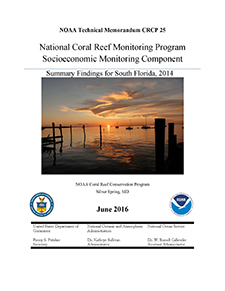-
Home
-
Data & Publications
-
Regional Portals
- About Regional Portals
- Florida
- Navassa Island
- Puerto Rico
- Flower Garden Banks
- U.S. Virgin Islands
- American Samoa
- Commonwealth of the Northern Mariana Islands
- Federated States of Micronesia
- Guam
- Main Hawaiian Islands
- Republic of the Marshall Islands
- Northwestern Hawaiian Islands
- Republic of Palau
- Pacific Remote Island Areas
-
CRCP Activities
- Glossary
National Coral Reef Monitoring Program Socioeconomic Monitoring Component. Summary Findings for South Florida, 2014

The Socioeconomic Component of the National Coral Reef Monitoring Program (NCRMP) is currently in the process of monitoring socioeconomic indicators across all United States (US) coral reef territories and jurisdictions. These indicators fall under the following broader categories: the demographics of these areas, human use of coral reef resources, and knowledge, attitudes, and perceptions of coral reefs and coral reef management. The overall goal of this endeavor is to track relevant information regarding each jurisdiction's population, social and economic structure, society's interactions with coral reef resources, and the responses of local communities to coral management. From there, these baseline data are used to develop indicators that describe the state of each jurisdiction and provide researchers with the ability to compare jurisdictions to one another. The National Oceanic and Atmospheric Administration's (NOAA) Coral Reef Conservation Program (CRCP) will use the information for future research, to assess the socioeconomic outcomes of management activities, and to improve the results of programs designed to protect coral reef resources.
This report outlines human dimensions information relevant to coral reef resources in South Florida. The South Florida region is defined as the five counties adjacent to the Florida Coral Reef Tract: Martin, Palm Beach, Broward, Miami-Dade, and Monroe Counties. The findings here are derived from a combination of data gathered through household surveys conducted from January to July of 2014, and additional secondary sources of socioeconomic information for the region.
With respect to human participation in recreational coral reef-related activities, the surveys demonstrated that South Florida residents participate in swimming and beach recreation most frequently. Additionally, just over 30% of residents indicated that they participate in fishing or gathering of marine resources. Though the sample was not large enough to be representative of each county's population, differences in perceptions concerning marine resource condition were identified between respondents based on county of residence. If perceptions of coral reef health truly vary by location, this may correlate to differing resource quality in different regions, which could, in part, explain the lack of consensus across counties concerning the condition of marine resources. Surveys also revealed that South Floridians generally support a range of potential marine management policies and regulations, and are generally familiar with the various threats faced by coral reefs (such as hurricanes, pollution, and coastal development).
Unlike several US coral reef jurisdictions, the population of South Florida increased between 2000 and 2010. In addition to a rising population, the jurisdiction faces a number of other social challenges including a decline in real gross domestic product since 2007, a decline in real median household income from 2000 to 2010, and an increase in the poverty rate from 2000 to 2010. The actions of humans in coastal communities have been shown to affect coral reefs in several ways and an estimated 30% of global coral reefs could already be considered "severely damaged" due to human-induced impacts (Hughes 2008). Coupled with the increasing impact of contaminant runoff, pressures from coastal development, and unsustainable levels of fishing in South Florida (FDEP 2011), there is little question about connection between communities and environment in this region. Conversely, it is also important to note that the communities of this region are positively connected to coral reef resources through the tourism industry, commercial fishing, and a range of recreational activities enjoyed by residents (NOAA CRCP 2015).
There were key lessons learned from this first NCRMP socioeconomic data collection in South Florida. For example, there is a need to fine-tune the survey question pertaining to fish consumption and fishing activity in order to make it more specific to coral reef related fish and invertebrate species, as well as a need to distinguish between locally caught and imported fish. Also, within the participation in coral reef related activities section, the team will add 'shelling' as an example under the 'beach recreation' category. And finally, Florida partners recommended that the scale for the familiarity with management agencies and processes question be simplified to assess the difference between respondents who are familiar, those who have heard of the agency or process, and those who are not familiar. As similar surveys are implemented across other US coral reef jurisdictions, the NCRMP team will be making adjustments to the data collection effort to improve on the type of information being generated. Thus, the findings contained within this report should be considered a starting point to the development of more detailed research questions for future work. Surveys are planned to be repeated in each US coral reef jurisdiction after the completion of a full monitoring cycle, approximately once every five to seven years.
Citation: M. Gorstein, M. Dillard, J. Loerzel, P. Edwards, and A. Levine. 2016. National Coral Reef Monitoring Program Socioeconomic Monitoring Component: Summary Findings for South Florida, 2014. US Dep. Commerce, NOAA Tech. Memo., NOAA-TM-NOS-CRCP-25, 57p. + Appendices. doi:10.7289/V5VH5KV5


